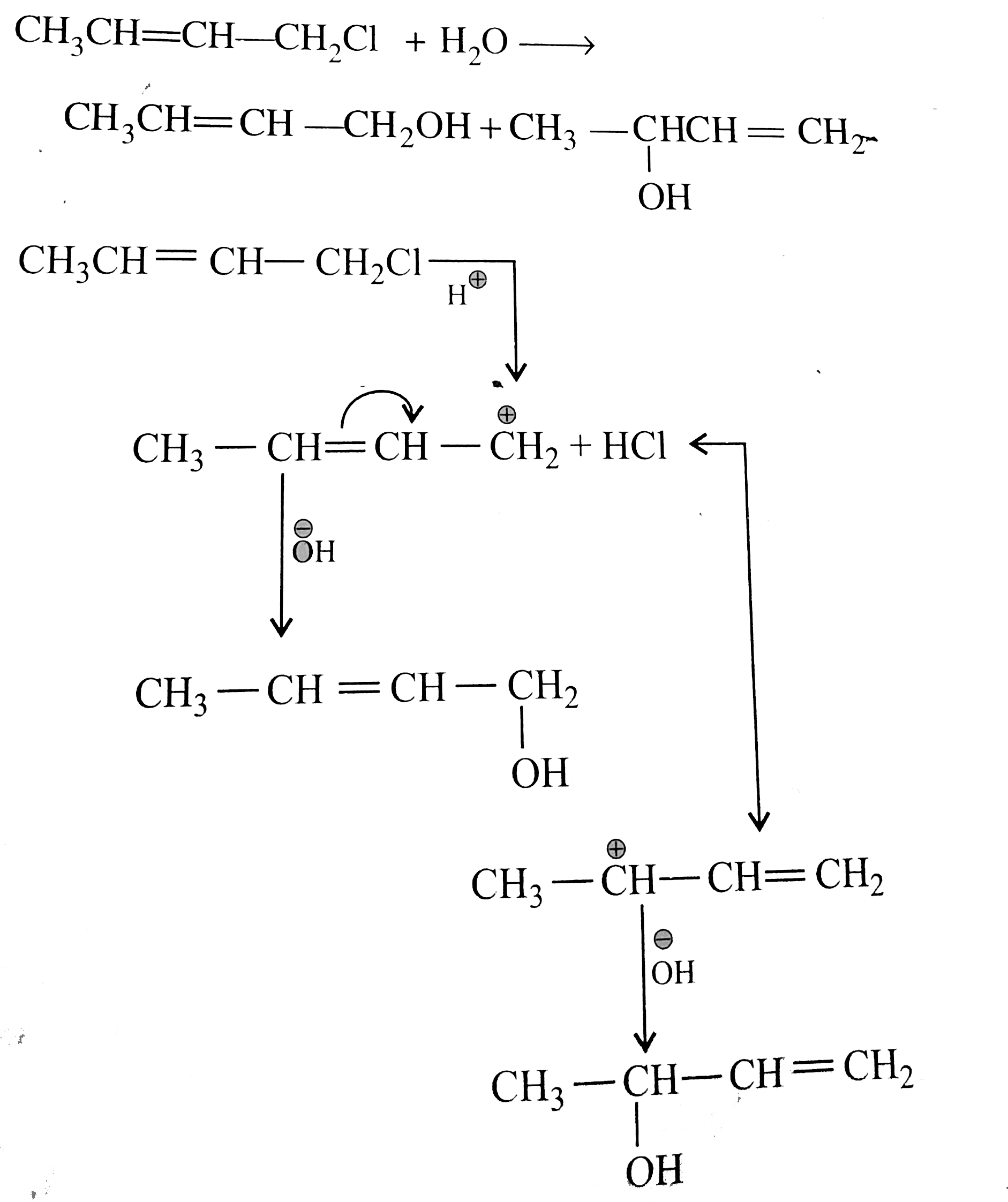In each of the following reactions, a new ring is formed. Use curved arrow notation to explain the formation of the new ring.
a. 1,4− Dibromobutance (0.1mol) is treated with sodiuk suplhile (0.1mol) in aqueous ethabnol.
b. 1− Choloro −2 (2− hyddroxyphenyl) ethane is treated with aquencous sodium hydroxide.
c. o− Methoxybenyl bromide reacts faster than p− nitrobenyzl bromide with ethanol to form an ether product. Explain why.
d. Explain the formation of the two products in the following reactions:

e. What mass of propene obtained from 34.0gm of I− iodopropane on heating with ethanolic KOH, if the yield is 36% ?
f. The nucleophilic substitution of primary alkyl chlorides with sodium acated acetate is catalysed by sodium iodide. Explain why.
Text Solution


The electron-dontaing group (−OCH3) by resonance increases the stabiliy of benzyl of benyl carbonium ion, whereas the electron-withdrawing group [(NO2) group] by resonance decreases the stablity of benzyl carbonium ion. Hence, reaction (1) is faster than (2) with ethanol to give ether by SN−1 mechanism.
d. 
Two products are formed due to allylic rearrangements.
e. CH3CH2CH2IEthanolic−−−−−−−→KOHCH3CH=CH2
Mw=170gm,Mw=42gm
170gm of iodopropane gives 42gm of propene.
34gm of iodopropane gives 42×34170=8.4gm
If the yield is 36% then Wt. of propene =8.4×34100
=3.024gm
f. R−Cl+CH3−COONa→R−O−O∣∣C−CH3+NaCl
This reaction is SN2. Nuclophile is CH3COO∘
 But in alkyl chloride, (C−Cl) is a strong bond and is difficult to break. But in the presence of Nal,(R−Cl) is converted to (R−I) (Finkelstein reaction) and therefore, in (R−1) the (C−1) bond is weak, which can e easily cleaved. So SN2 reaction is cataysed in the presence of Nal.
But in alkyl chloride, (C−Cl) is a strong bond and is difficult to break. But in the presence of Nal,(R−Cl) is converted to (R−I) (Finkelstein reaction) and therefore, in (R−1) the (C−1) bond is weak, which can e easily cleaved. So SN2 reaction is cataysed in the presence of Nal.
R−Cl+Nal→R−I+NaCl

|
Topper's Solved these Questions
- AROMATIC COMPOUNDS AND ALKYL AND ARYL HALIDES BOOK - CENGAGE CHEMISTRYCHAPTER - AROMATIC COMPOUNDS AND ALKYL AND ARYL HALIDES EXERCISE - Exercises Concept Application
4 Videos
- AROMATIC COMPOUNDS AND ALKYL AND ARYL HALIDES BOOK - CENGAGE CHEMISTRYCHAPTER - AROMATIC COMPOUNDS AND ALKYL AND ARYL HALIDES EXERCISE - Exercises Linked Compreshension Type
11 Videos
- AROMATIC COMPOUNDS AND ALKYL AND ARYL HALIDES BOOK - CENGAGE CHEMISTRYCHAPTER - AROMATIC COMPOUNDS AND ALKYL AND ARYL HALIDES EXERCISE - Exercises Subjective
17 Videos
- APPENDIX INORGANIC VOLUME 2BOOK - CENGAGE CHEMISTRYCHAPTER - APPENDIX INORGANIC VOLUME 2EXERCISE - Short Answer Type
179 Videos
- BIOMOLECULESBOOK - CENGAGE CHEMISTRYCHAPTER - BIOMOLECULESEXERCISE - Exercises Archives (Analytical And Descriptive)
8 Videos
Similar Questions
Knowledge Check
Reaction of methyl bromide with aqueous sodium hydroxide involves
ARacemizationBSN1 mechanismCRetention of configurationDSN2 mechanismReaction of methyl bromide with aqueous sodium hydroxide involves
AReacemisationBSN1 mechanismCInversion of configurationDSN2 mechanismReaction of tert-butyl bromide with aqueous sodium hydroxide follow
ASN1 mechanismBSN2 mechanismCAny of the above two depending upon temperature of reactionDSaytzeff rule
In each of the following reactions, a new ring is formed. Use curved arrow notation to explain the formation of the new ring.
a. 1,4− Dibromobutane (0.1mol) is treated with sodium sulphide (0.1mol) in aqueous ethanol.
b. 1− Choloro −2 (2− hydroxyphenyl) ethane is treated with aqueous sodium hydroxide.
View Solution(a) The nucleophilic substitution of primary alkyl chlorides with sodium acetate is catalysed by sodium iodide.
(b) p-Methoxybenzayl bromide reacts faster than p-nitrobenzyl bromide with ethanol to form a ether product.
View SolutionReaction of methyl bromide with aqueous sodium hydroxide involves
View Solutionn-propyl bromide reacts with aqueous KOH to form:-
View Solutionn-propyl bromide reacts with aqueous KOH to form:-
View Solution
